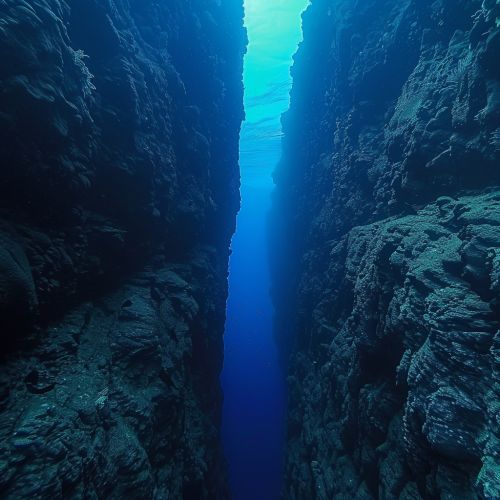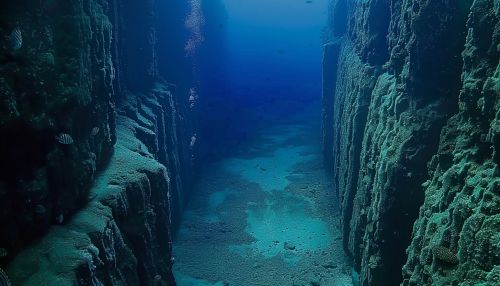Puerto Rico Trench: Difference between revisions
(Created page with "== Introduction == The **Puerto Rico Trench** is an oceanic trench located on the boundary between the Caribbean Sea and the Atlantic Ocean. It is the deepest part of the Atlantic Ocean and is situated north of Puerto Rico and the Dominican Republic. The trench is a significant geological feature, known for its complex tectonic activity and profound depths. This article delves into the geological, biological, and historical aspects of the Puerto Rico Trench, providing a...") |
No edit summary |
||
| Line 13: | Line 13: | ||
The trench reaches a maximum depth of approximately 8,376 meters (27,480 feet) at a point known as the Milwaukee Deep. It extends for about 800 kilometers (500 miles) in length and has an average width of 100 kilometers (62 miles). The immense depth and length of the trench make it a prominent feature in the Atlantic Ocean. | The trench reaches a maximum depth of approximately 8,376 meters (27,480 feet) at a point known as the Milwaukee Deep. It extends for about 800 kilometers (500 miles) in length and has an average width of 100 kilometers (62 miles). The immense depth and length of the trench make it a prominent feature in the Atlantic Ocean. | ||
[[Image:Detail-92285.jpg|thumb|center|Underwater view of the Puerto Rico Trench, showing the steep walls and deep abyss.|class=only_on_mobile]] | |||
[[Image:Detail-92286.jpg|thumb|center|Underwater view of the Puerto Rico Trench, showing the steep walls and deep abyss.|class=only_on_desktop]] | |||
=== Geological History === | === Geological History === | ||
Latest revision as of 07:55, 15 June 2024
Introduction
The **Puerto Rico Trench** is an oceanic trench located on the boundary between the Caribbean Sea and the Atlantic Ocean. It is the deepest part of the Atlantic Ocean and is situated north of Puerto Rico and the Dominican Republic. The trench is a significant geological feature, known for its complex tectonic activity and profound depths. This article delves into the geological, biological, and historical aspects of the Puerto Rico Trench, providing a comprehensive understanding of its significance.
Geological Formation
Tectonic Setting
The Puerto Rico Trench is formed by the interaction of the North American Plate and the Caribbean Plate. This interaction is characterized by a subduction zone where the North American Plate is being subducted beneath the Caribbean Plate. The trench marks the boundary between these two tectonic plates and is a site of significant seismic activity.
Depth and Dimensions
The trench reaches a maximum depth of approximately 8,376 meters (27,480 feet) at a point known as the Milwaukee Deep. It extends for about 800 kilometers (500 miles) in length and has an average width of 100 kilometers (62 miles). The immense depth and length of the trench make it a prominent feature in the Atlantic Ocean.


Geological History
The formation of the Puerto Rico Trench dates back to the Late Cretaceous period, around 70 million years ago. The tectonic activity in the region has continuously shaped the trench, leading to its current structure. The subduction process has also resulted in the formation of the Puerto Rico-Virgin Islands microplate, a small tectonic plate caught between the larger North American and Caribbean Plates.
Seismic Activity
Earthquakes
The Puerto Rico Trench is a seismically active region, with frequent earthquakes occurring due to the subduction of the North American Plate beneath the Caribbean Plate. These earthquakes can range from minor tremors to significant seismic events. One of the most notable earthquakes in the region was the 1918 San Fermín earthquake, which had a magnitude of 7.1 and caused considerable damage in Puerto Rico.
Tsunamis
The seismic activity in the Puerto Rico Trench also poses a risk of tsunamis. The subduction zone is capable of generating large undersea earthquakes that can displace significant volumes of water, leading to the formation of tsunamis. Historical records indicate that the region has experienced several tsunamis, with the most recent significant event occurring in 1946.
Biological Significance
Marine Life
The depths of the Puerto Rico Trench harbor a unique and diverse array of marine life. The extreme conditions of high pressure, low temperature, and complete darkness create a challenging environment for organisms. Despite these harsh conditions, the trench is home to various species of deep-sea fish, crustaceans, and other invertebrates. Notable species include the giant squid and the deep-sea anglerfish.
Hydrothermal Vents
Hydrothermal vents are another significant feature of the Puerto Rico Trench. These vents are formed by the interaction of seawater with the hot magma beneath the ocean floor, resulting in the release of mineral-rich fluids. The unique chemical environment around these vents supports a diverse community of organisms, including chemosynthetic bacteria, tube worms, and various crustaceans.
Human Exploration
Historical Expeditions
The Puerto Rico Trench has been the subject of numerous scientific expeditions aimed at exploring its depths and understanding its geological and biological significance. Early expeditions in the 20th century used basic deep-sea submersibles and remotely operated vehicles (ROVs) to explore the trench. These missions provided valuable insights into the trench's structure and the organisms inhabiting it.
Modern Research
Advancements in technology have enabled more detailed and comprehensive exploration of the Puerto Rico Trench. Modern research vessels equipped with advanced sonar systems, ROVs, and autonomous underwater vehicles (AUVs) have mapped the trench in high resolution and collected samples from its depths. These studies have contributed to a better understanding of the trench's geology, seismic activity, and biological communities.
Environmental Concerns
Pollution
The Puerto Rico Trench, like many deep-sea environments, is not immune to the impacts of human activities. Pollution, particularly plastic debris, has been found in the trench, posing a threat to its unique marine life. Efforts are being made to monitor and mitigate the impact of pollution on this fragile ecosystem.
Climate Change
Climate change is another significant concern for the Puerto Rico Trench. Changes in ocean temperature and chemistry can affect the delicate balance of the trench's ecosystem. Research is ongoing to understand the potential impacts of climate change on deep-sea environments and to develop strategies for their conservation.
